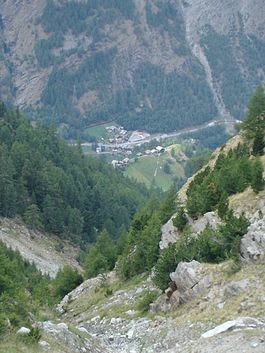Eisten
| Eisten | ||
|---|---|---|

Eisten village
|
||
|
||
| Coordinates: 46°12′N 7°54′E / 46.200°N 7.900°ECoordinates: 46°12′N 7°54′E / 46.200°N 7.900°E | ||
| Country | Switzerland | |
| Canton | Valais | |
| District | Visp | |
| Government | ||
| • Mayor | Bruno Andenmatten | |
| Area | ||
| • Total | 38.05 km2 (14.69 sq mi) | |
| Elevation | 1,084 m (3,556 ft) | |
| Population (Dec 2015) | ||
| • Total | 201 | |
| • Density | 5.3/km2 (14/sq mi) | |
| Postal code | 3922 | |
| SFOS number | 6282 | |
| Surrounded by | Grächen, Saas Balen, Sankt Niklaus, Simplon, Stalden, Staldenried, Visperterminen | |
| Website |
www SFSO statistics |
|
Eisten is a municipality in the district of Visp in the canton of Valais in Switzerland.
Eisten is first mentioned in 1299 as Oysten.
Eisten has an area, as of 2011[update], of 38 square kilometers (15 sq mi). Of this area, 9.6% is used for agricultural purposes, while 23.9% is forested. Of the rest of the land, 0.7% is settled (buildings or roads) and 65.8% is unproductive land.
The municipality is located in the Visp district, on the eastern and western sides of the entrance into the Saas valley. It lies east of the Mischabel range, which culminates at the Dom (4,545 m [14,911 ft]).
The blazon of the municipal coat of arms is Vert, a Lamb Argent passant over a Coupeaux Or, a chief Azure.
Eisten has a population (as of December 2015[update]) of 201, all Swiss citizens. Over the last 10 years (2000–2010 ) the population has changed at a rate of -22%. It has changed at a rate of -5.7% due to migration and at a rate of -5.7% due to births and deaths.
Most of the population (as of 2000[update]) speaks German (217 or 96.0%) as their first language, Albanian is the second most common (7 or 3.1%) and Romansh is the third (1 or 0.4%).
As of 2008[update], the population was 48.5% male and 51.5% female. The population was made up of 100 Swiss men and 106 Swiss women. Of the population in the municipality, 184 or about 81.4% were born in Eisten and lived there in 2000. There were 23 or 10.2% who were born in the same canton, while 6 or 2.7% were born somewhere else in Switzerland, and 12 or 5.3% were born outside of Switzerland.
...
Wikipedia




